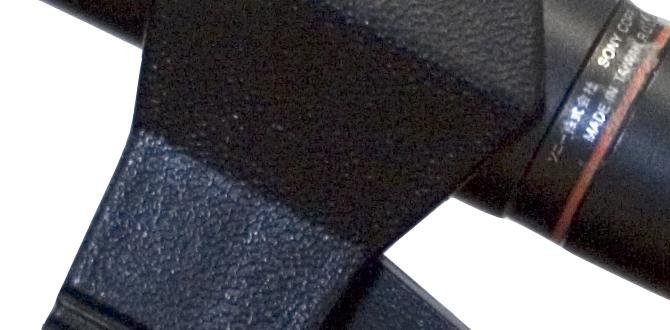Shotgun Microphone Tutorial: Essential Guide
Unlock professional audio with a shotgun microphone! This essential guide breaks down how to use shotgun mics to capture focused sound, minimize background noise, and elevate your videos, podcasts, and film projects. Learn setup, handling, and best practices for crystal-clear recordings, even in challenging environments.
Ever felt like your audio just isn’t cutting it? You’ve got great visuals, but the sound is muddy, full of echo, or just plain distracting. It’s a common frustration for creators of all levels. The good news? A shotgun microphone might be the secret weapon you need. These impressive tools can make a world of difference in capturing clear, focused sound, and using one isn’t as complicated as you might think. We’re going to walk through everything you need to know, step-by-step, to get fantastic audio results. Get ready to level up your sound game!
What is a Shotgun Microphone and Why Use One?
So, what exactly is this magical device called a shotgun microphone? Think of it as an audio spotlight. Unlike many microphones that pick up sound from all directions, a shotgun microphone is designed to be highly directional. This means it primarily “hears” what’s directly in front of it, while doing an excellent job of ignoring sounds coming from the sides and rear. This super-cardioid or highly directional polar pattern is its main superpower.
The Benefits of Going “Shotgun”
Why would you choose a shotgun mic over others? The advantages are pretty significant, especially for specific recording situations:
Focused Sound Capture: This is the number one reason. You can point the mic directly at your subject (a speaker, an actor, a specific instrument) and get clean audio of that sound, rather than a messy mix of everything nearby.
Reduced Background Noise: In busy environments like city streets, crowded events, or windy outdoor locations, a shotgun mic excels at isolating your desired sound source from the surrounding din.
Professional Sound Quality: Filmmakers, videographers, podcasters, and broadcasters often rely on shotgun mics to achieve that polished, in-the-studio sound, even when filming on location.
Improved Clarity for Dialogue: For spoken word, whether in a film, interview, or podcast, clarity is king. Shotgun mics help ensure every word is heard distinctly.
Versatility: While often associated with filmmaking, they’re also great for recording wildlife sounds, specific instruments in a live mix, or even capturing ambiance for sound design.
When is a Shotgun Microphone NOT the Best Choice?
While powerful, a shotgun mic isn’t always the perfect tool for every job. If you’re recording a group of people in a quiet room where everyone is speaking equally, a more omnidirectional or even a condenser microphone placed centrally might be better. Shotgun mics also require careful aiming. If your subject is moving around a lot, or you can’t easily position the mic close to them, you might struggle to keep the sound consistent.
Types of Shotgun Microphones
Just like there are different types of cars, there are different kinds of shotgun microphones, each suited for different needs and budgets.
Internal vs. External Shotgun Microphones
When you first start looking, you’ll notice a distinction between mics that attach directly to your camera and those that are used separately.
Camera-Mount Shotgun Mics: These are often smaller, lighter, and designed to mount directly onto your camera’s hot shoe or a bracket. They are very convenient for run-and-gun shooting. However, they can sometimes be a bit noisy due to the proximity to the camera’s electronics and lenses. They usually plug directly into your camera’s microphone input.
External/Boom Shotgun Mics: These are typically larger, more professional-grade microphones. They are usually mounted on a boom pole, stand, or handled by a boom operator. They offer superior sound quality and better directionality but require more setup and often external power or a separate audio recorder.
Polar Patterns: The Heart of Directionality
The directionality of a microphone is described by its “polar pattern.” For shotgun microphones, you’ll most commonly encounter:
Supercardioid: This pattern focuses sound primarily from the front, with a narrow pickup area. It rejects sound from the sides quite effectively but has a small lobe of sensitivity directly in the rear.
Hypercardioid: Even narrower than supercardioid, this pattern offers more side rejection but a more pronounced rear lobe.
While true shotgun microphones are characterized by their interference tube design, which further enhances their directivity, the underlying polar pattern is key to understanding their behavior.
Essential Gear to Go With Your Shotgun Microphone
A shotgun microphone is a fantastic start, but to get the best results and protect your investment, you’ll need a few other pieces of gear.
The Must-Haves:
Shock Mount: This is crucial! Wind, handling noise, and vibrations from your camera can all travel up the mic stand or boom pole and into your audio. A shock mount isolates the microphone, preventing these unwanted noises. Many shotgun mics come with one, or you’ll need to purchase one that fits your mic.
Wind Protection (Windscreen/Blimp): If you plan to record outdoors, or even in a breezy indoor location, wind protection is non-negotiable.
Foam Windscreen: These are simple foam covers that slip over the microphone. They offer basic protection against light breezes and plosives (like “P” and “B” sounds).
Furry Windjammer (Deadcat): This is a furry cover that goes over the foam windscreen (or directly over the mic for non-foam models). It significantly reduces wind noise, making it essential for outdoor shoots.
Blimp/Zeppelin: For serious professional use or very windy conditions, a blimp is the ultimate solution. It’s a cage-like structure that surrounds the microphone, creating a large pocket of still air. Often, these come with their own internal shock mount and a fuzzy cover.
Audio Cable: A high-quality XLR cable is standard for most professional shotgun microphones. Ensure it’s long enough for your setup and in good condition. Some camera-mount mics might use a 3.5mm (1/8-inch) TRS connection.
Headphones: You absolutely must wear headphones while recording with any microphone, but especially with a shotgun. This allows you to monitor the sound in real-time, catch background noise, adjust levels, and ensure your subject is speaking clearly. Closed-back headphones are ideal as they prevent sound from leaking into the microphone.
Camera or Audio Recorder: You need something to capture the audio. This could be your video camera, a DSLR, a mirrorless camera with an audio input, or a dedicated audio recorder like a Zoom H4n Pro or Tascam DR-40X.
The Nice-to-Haves:
Boom Pole: If you’re not recording with the mic directly on camera, a boom pole allows you to extend the microphone further away from the camera, closer to your subject, for much better audio quality without appearing in the shot.
Mic Stand: A sturdy mic stand is useful for stationary setups or when you don’t have a boom operator.
Audio Interface/Mixer: For more advanced setups, an audio interface or mixer can give you more control over preamps, levels, and routing.
How to Set Up Your Shotgun Microphone: A Step-by-Step Guide
Let’s get hands-on! Setting up your shotgun microphone is straightforward once you know the basic principles.
Step 1: Choose Your Mounting Option
Decide how you’ll position your mic:
On-Camera: If using a camera-mount mic, attach it to your camera’s hot shoe. Ensure it’s securely fastened.
Boom Pole/Stand: If using an external mic, attach it to your boom pole’s threaded tip (usually 3/8-inch or 5/8-inch) or a mic stand adapter. Make sure it’s pointing in the direction you want to capture sound.
Step 2: Attach the Shock Mount
If your microphone doesn’t come integrated with a shock mount (most good ones do), carefully place the microphone into the shock mount’s cradle. Secure it using any locking mechanisms. Ensure the mic is held firmly but not squeezed excessively.
Step 3: Add Wind Protection
This is where you protect your audio from the elements:
Foam Windscreen: Slide the foam windscreen over the microphone capsule. Ensure it fits snugly and covers the entire sensitive part of the mic.
Furry Windjammer (Deadcat): If using a furry cover, place it over the foam windscreen. It should fit snugly and zip or tie closed if necessary.
Blimp: Carefully insert the microphone (often already in its shock mount) into the blimp. Secure the blimp and attach the outer fuzzy cover if it’s a separate piece.
Step 4: Connect the Microphone to Your Recorder
This is where you get the audio signal from the mic to your recording device:
XLR Connection: Plug one end of your XLR cable into the microphone’s XLR port. Plug the other end into the XLR input on your camera, audio recorder, or mixer.
3.5mm Connection: For smaller camera-mounted mics, plug the 3.5mm connector into your camera’s microphone input.
Phantom Power (For some mics): Some professional shotgun mics require phantom power to operate. This is usually supplied by the camera, audio recorder, or mixer via the XLR cable. Look for a “+48V” switch on your device. If your mic requires it, ensure phantom power is turned ON. Most camera-mount mics do not need phantom power.
Step 5: Connect Headphones and Monitor
This is NON-NEGOTIABLE for good audio.
Plug your closed-back headphones into the headphone jack on your camera, audio recorder, or mixer.
Turn your monitoring device on.
Step 6: Set Initial Audio Levels
This is a critical step that many beginners overlook.
Mic Placement: Position the shotgun microphone as close to your intended sound source (e.g., the speaker’s mouth) as possible without it being visible in the shot. For interviews, aim roughly 6-12 inches (15-30 cm) from the talent’s mouth.
Test Audio: Have your subject speak naturally. Watch your audio level meters on your camera or recorder.
Target Level: Aim for your audio levels to peak around -12 dB to -6 dB on the meter. This provides plenty of headroom to avoid clipping (distortion from overmodulation) while still capturing a strong signal. Avoid letting the levels hit 0 dB or go into the red.
Gain Staging: The “gain” is the initial amplification of the microphone’s signal. Adjust your camera’s or recorder’s mic pre-amp gain until you achieve the desired level without excessive background noise.
Step 7: Record and Monitor
Start recording.
Continuously wear your headphones. Listen for any unwanted noises: wind, handling noise, background conversations, hums, or buzzes.
If you hear problems, adjust your mic position, wind protection, or levels.
Best Practices for Using Your Shotgun Microphone
Simply having the gear isn’t enough; knowing how to use it makes all the difference.
1. Get Close (But Not Too Close!)
The closer the microphone is to the sound source, the cleaner and more direct the audio will be. This is especially true with directional microphones like shotguns. Aim for the sweet spot: close enough for detail, but far enough to avoid plosives, breath sounds, and appearing in the shot.
2. Aiming is Everything
Remember that audio spotlight? You need to point it precisely. The narrow pickup pattern means if you’re slightly off, the sound quality will suffer. Practice aiming your mic. For dialogue, aim it directly at the speaker’s mouth.
3. Understand Your Environment
Shotgun mics excel at rejecting ambient noise, but they’re not magic.
Indoors: In moderately quiet rooms, you might get away with just a foam windscreen. However, reflections off hard surfaces (walls, windows) can cause echo or “room tone” that can be difficult to remove later.
Outdoors: Wind is the enemy. Always use a furry windjammer or blimp in even the slightest outdoor breeze. Constant low-frequency rumble from wind will ruin your audio.
Noisy Locations: In very noisy areas, get the mic as close to your talent as possible. You might also consider using an absorbent barrier (like a thick blanket or acoustic panel, if feasible) behind your talent to help isolate them further.
4. Minimize Handling Noise
If you’re holding the mic on a boom pole, be gentle! Any bumps, taps, or rustling of the pole will be picked up. Ensure your shock mount is doing its job and practice smooth movements.
Here’s a quick comparison of wind protection effectiveness:
| Protection Type | Pros | Cons | Best For |
|---|---|---|---|
| Foam Windscreen | Lightweight, inexpensive, easy to use. | Minimal wind protection, no protection against handling noise. | Very light breezes, indoor use, plosive reduction. |
| Furry Windjammer (Deadcat) | Excellent wind noise reduction, attaches easily over foam. | Bulky, can sometimes slightly affect high frequencies, not a shock mount. | Outdoor filming, moderate to strong winds. |
| Blimp/Zeppelin | Superior wind noise reduction (near-silent in gales), excellent isolation. | Expensive, bulky, heavier, requires specific mounting. | Professional film sets, extreme wind conditions, critical audio. |
5. Use Consistent Gain Settings
Once you’ve found good gain settings in a quiet environment, try to stick with them. If you have to constantly boost the gain in a noisy scene, you’ll also be boosting the unwanted noise. Better to have slightly lower levels that are clean than loud, noisy levels.
6. Consider the Microphone’s Directionality Carefully
The narrower the pickup pattern (e.g., hypercardioid vs. supercardioid), the more rejection you get from the sides, but also a smaller “window” to aim at your subject. Experiment to find what works best for your specific mic and situation. Learning about microphone polar patterns can be a deep dive, but understanding that yours is designed to be aimed is the main takeaway. For more on polar patterns, check out the International Telecommunication Union’s recommendations on sound fields, which touch upon these principles.
7. Maintain Your Gear
Keep your microphones clean and dry. Store them in their cases when not in use. Check cables for fraying or damage. Clean windscreens and furry covers according to the manufacturer’s instructions.
Troubleshooting Common Shotgun Mic Issues
Even with the best intentions, you might run into problems. Here are a few common ones and how to fix them:
Problem: Lots of rumble or “thump” in my audio.
Cause: This is almost always handling noise or wind noise.
Solution: Make sure your microphone is properly seated in a good shock mount. If recording outdoors or in a breezy area, you need a furry windjammer or blimp. Be gentler when moving boom poles.
Problem: My audio sounds muffled or distant.
Cause: The microphone might not be close enough to the subject, or wind protection might be significantly dampening high frequencies.
Solution: Move the microphone closer. If using a furry windjammer or blimp, ensure it’s a high-quality one designed not to muffle the sound excessively. Sometimes, a slightly different mic angle can help.
Problem: I’m getting a low hum or buzz.
Cause: This can be electrical interference (ground loop, nearby lights, AC power), or sometimes a faulty cable.
Solution: Try moving your recording equipment away from power sources or noisy electronics. If possible, use a different XLR cable. Ensure your camera/recorder has a good audio input. Using a battery-powered recorder often helps isolate from camera power.
Problem: My microphone isn’t producing any sound.
Cause: It’s a connectivity issue, or the mic isn’t receiving power.
Solution: Double-check all cable connections. Ensure phantom power (+48V) is switched on if your microphone requires it. Test with a different cable. If it’s a camera-mount mic, ensure it’s properly plugged into the camera’s mic input, and check your camera’s audio settings to ensure it’s set to use the external mic.
Here’s a quick look at typical microphone sensitivities and self-noise, which impact how quiet your recordings can be:
| Characteristic | Typical Range for Shotgun Mics | What it Means for You |
|---|---|---|
| Sensitivity | -38 dBV to -18 dBV (or equivalent in mV/Pa ≈ 12.6 mV/Pa to 126 mV/Pa) | Higher number (e.g., -18 dBV) means the mic outputs a stronger signal for
|






